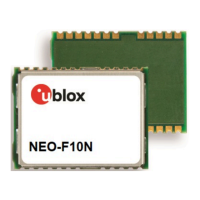NEO-F10N-Integration manual
The length and geometry in the RF signal line must be carefully analyzed. The impedance of the RF
signal line must be 50 Ω. Select the stack-up, copper, and dielectric properties of the PCB accordingly
to fulfill this condition. The RF signal line should be as short as possible and the ground plane around
should be filled with GND vias.
The RF trace must be shielded by vias to ground along the entire length of the trace and the NEO-
F10N RF_IN pad should be surrounded by vias as shown in Figure 7.
Figure 7: RF input trace
The RF_IN trace on the top layer should be referenced to a suitable ground layer.
The VCC pad for the NEO-F10N Standard precision GNSS module needs to have as low an
impedance as possible with large vias to the lower power layer of the PCB. The VCC pad needs a large
pad and the decoupling capacitor must be placed as close as possible. This is shown in Figure 8.
Figure 8: VCC pad
Be careful when placing the receiver in proximity to circuitry that can emit heat. Temperature-
sensitive components inside the module, like TCXOs and crystals, are sensitive to sudden changes
in ambient temperature which can adversely impact satellite signal tracking. Sources can include
co-located power devices, cooling fans or thermal conduction via the PCB.
The GND planes can conduct heat to other elements, but they can act as heat dissipators as well.
Increasing the number of GND vias helps to decrease sudden temperature changes.
UBXDOC-963802114-12193 - R02
4 Hardware integration Page 25 of 42
C1-Public

